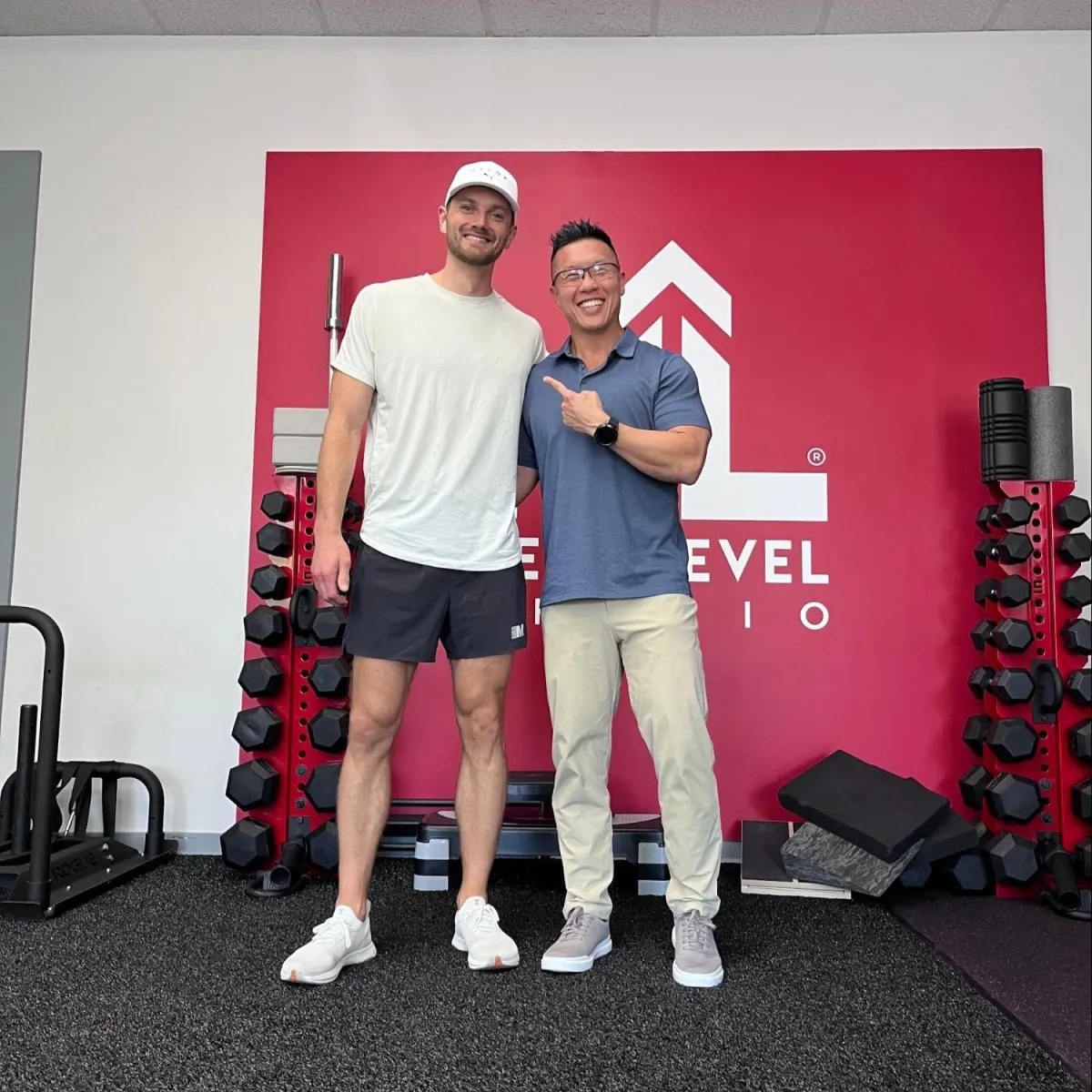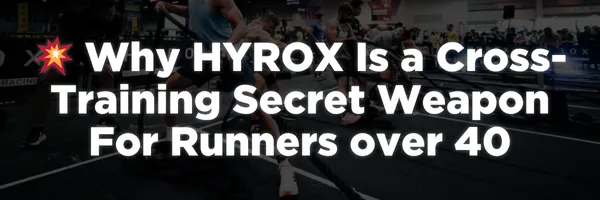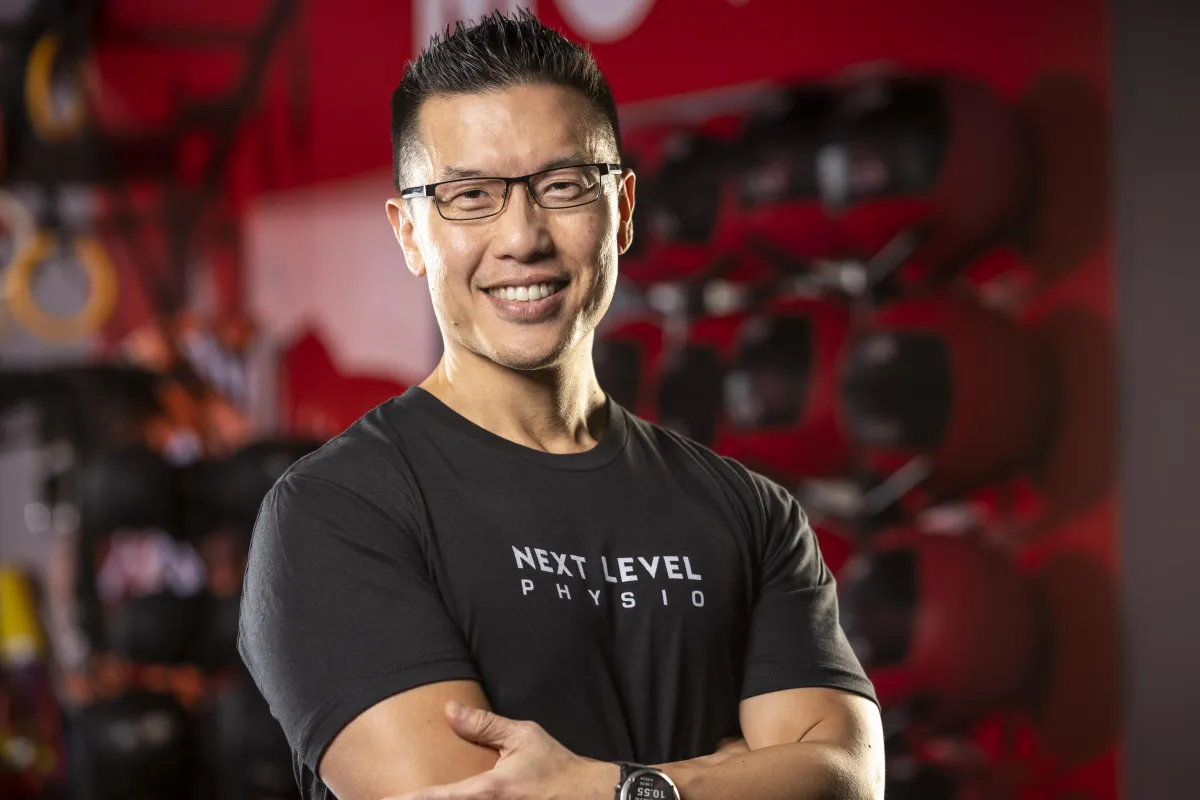
Why Top Runners and Endurance Athletes over 40 Are Quietly Using HYROX to Out-train You
(And Why You’ll Fall Behind If You Don’t)
5 MINUTE READ

By: Dr. Jerry Yoo
CEO & Founder, Next Level Physio
How High-Performing Endurance Athletes Are Building Stronger Engines, Breaking PRs,
and Staying Pain-Free—Without More Miles or More Injuries

It started with burpee broad jumps.
While I had known about it at a very surface level for the past 5 years, I wasn’t planning on getting into HYROX.
Honestly, I thought it was just another fitness trend—like Crossfit or Spartan races, which I had done in the past, but with a better logo.
But then I watched athletes running, rowing, pushing sleds, doing wall balls… all at race pace.
No obstacles.
No gimmicks.
Just pure output and grit.
This was definitely when my competitive self became more and more drawn to it.
For those who know me, I love stress testing my fitness… because I’m a little sick in the head that way (for those who just LOL’d, you either know that about me, or you love pushing the limits, too!).
As someone who works with high-performing men and women- runners, triathletes, and hybrid athletes every day at Next Level Physio, I’m always chasing better ways to train smart, stay healthy, while helping clients continue to push their limits, safely, as they get older.
Hybrid training, particularly, HYROX, checked every box. So, I dove in.

HYROX has exploded globally over the past 10 years… to the point where I could no longer ignore it.
When I connected with Stephen Pelkofer through my friend Sammy Siegel, owner of Empire Training Academy in Raleigh, which is a HYROX training center, I realized I was talking to someone who wasn’t just dabbling in HYROX—he was dominating it.
🥈 2nd Place – 2025 HYROX North American Championships (Men’s Doubles, 30–34)
🕒 Two sub-60 minute Pro finishes – with a blistering 59:41 PR, putting him in an elite global tier (for those who don’t know- a sub-60 minute time is ridiculously hard. Read the race format below!)
What stood out, though, wasn’t just his stats. It was how he thinks about training—and more importantly, how he helps athletes build performance without burnout. As a former data scientist, Stephen focuses on using data for his own training and coaching clients.
All of this can add up to one thing: chronic tissue breakdown that no amount of foam rolling will fix.
Read Stephen’s guest blog on lactate threshold training here:

Stephen breaks it down in a way that will click for all of you. Here are the big takeaways:
It’s not about training harder. It’s about lasting longer at hard.
If you’re a runner or triathlete, you’ve probably hit a wall in training and wondered: “Am I overreaching? Or just under-recovering?” While Zone 2 training has always been the buzz word in running circles, the real issue may be a lack of focused lactate threshold training.
Here’s what that means in plain English:
Lactate isn’t bad. It’s actually a useful fuel source. But most athletes struggle because they can’t clear it efficiently.
Threshold is the “sweet spot.” It’s where you can go hard—but stay there longer. That’s where endurance is built.
You don’t need a lab to find your zone. You can use estimated 10K pace, perceived effort, or Stephen’s simple field tests to start training smarter right now.
This isn’t just theory—it’s how we already train our clients in Phase 2 and Phase 3 of our hybrid performance model at Next Level Physio.

What’s genius about HYROX-style workouts is how they naturally mimic the demands of endurance racing under fatigue- essentially, real-time threshold training with movement variety built in.
In case you don’t know what a HYROX event is comprised of, here’s the race format (total of 8000 meters and 8 exercise stations)
The Hyrox Race Format (in order):
1,000m Run
1,000m Ski Erg
1,000m Run
50m Sled Push (very heavy)
1,000m Run
50m Sled Pull (very heavy)
1,000m Run
80m Burpee Broad Jumps
1,000m Run
1,000m Row
1,000m Run
200m Farmers Carry (very heavy)
1,000m Run
100m Sandbag Lunges (very heavy)
1,000m Run
75/100 Wall Balls (weight depending on gender)
That’s a full-body lactate management system in action. And that’s why more and more runners and triathletes are using HYROX training to boost performance without breaking down.
This type of training builds what’s called metabolic resilience—that gear you need at mile 20 of a marathon or when the wheels start to come off on the bike leg.

Because too many endurance athletes are stuck in the middle:
Not strong enough to hold form late in races
Not fast enough to make breakthroughs
No Progressive strength program
Constantly toeing the line between injury and progress
As with many things in life, if you don’t train it, you lose it…and, when you’re over 40, your ability to push hard can decline rapidly, which can adversely affect race performance.
As with many things in life, if you don’t train it, you lose it…and, when you’re over 40, your ability to push hard can decline rapidly, which can adversely affect race performance.
Recover smarter with tools like BFR and EPAT
Rebuild intelligently with movement-based strength work
Reintegrate into performance training with targeted coaching

Later this month, I’ll be sitting down with Stephen and HYROX Pro Dylan Scott to talk shop. These guys are redefining what hybrid performance looks like—and what everyday athletes can take from the top tier of competition.
We’ll cover:
How they train for sub-60 minute races
The biggest mistakes new HYROX athletes make
How to train for your first HYROX event if you’re over 40
You don’t want to miss it.
Until then, book your free hybrid athlete consult with Dr. Jerry and Coach Stephen below ⬇️
Let’s talk about how to build the engine you need—without injury, burnout, or wasted effort.

About the Author
Dr. Jerry Yoo is the Founder of Next Level Physio.
He has worked with runners and triathletes for over 25 years, and is a clinical running research partner with Rutgers University. Dr. Jerry is an expert at helping runners and lifelong athletes over 40 get back to what they love to do.
He can be reached directly at
Post Address and Mail
Email: info@nlphysio.com
Address
1055 Darrington Drive
Cary, NC 27513
Address
4000 Wake Forest Rd Suite 112, Raleigh, NC 27609
Get In Touch
Hours
Mon - Fri: 9:00 am- 6:00 pm
Sat: By Appointment (8:00 am - 12:00 nn)
Sun: Closed
Phone Number:
919-650-4633

Facebook
Instagram
X
LinkedIn
Youtube
Website